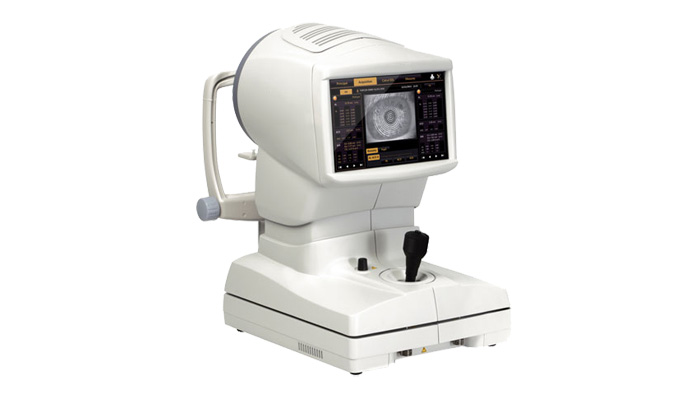ALADDIN hw3
ALADDIN HW3 is intended for the determination of ocular biometric measurements: axial length, corneal curvature radii of the flattest and most curved meridians with the corresponding axis, depth of the anterior chamber, central corneal thickness, lens thickness of the lens, diameter determination of "white to white" (WTW) and of the pupil of the human eye. It also provides further investigation of the anterior corneal surface based on corneal topography.

For patients who are candidates for intraocular lens implantation (IOL), ALADDIN HW3 supports physicians in calculating the appropriate potency and type of IOL to be implanted after removal of the natural lens.
ALADDIN HW3 is intended for use by doctors and eye care professionals and may only be used under the supervision of a doctor.
Functional description
ALADDIN HW3 is a combined device for measuring various parameters useful for the application of intraocular lenses. The tool can work in two different ways:
- Consecutive acquisition of all the measures available on the instrument
- Single acquisitions for each type of measure
ALADDIN HW3 includes eight types of measurements in one tool:
- Axial length
- Corneal topography
- Keratometry
- Corneal diameter (White to white)
- Pupillometry
- Depth of the anterior chamber
- Central corneal thickness
- Lens thickness
Axial length is the distance between the corneal apex and the internal limiting membrane. It is measured with a low coherence interferometry system with a superluminescent diode. The measuring range is from 15 mm up to over 38 mm.
ALADDIN HW3 allows the acquisition of corneal topography of the eye. The "Corneal Map" is obtained from the reflection of 24 rings of Placido disc, at a distance of about 80 mm from the patient's eye.
Keratometry is used for the measurement of corneal curvature. It is based on the reflection of the Placido disk on the eye, at a controlled working distance for a high measurement accuracy.
With the acquisition of corneal topography it is possible to determine the Corneal Diameter, also called "white to white" distance.
The Pupillometry is made with LEDs of different wavelengths. In particular, the instrument uses infrared LEDs for pupil dilation and white LEDs to reproduce photopic light conditions and pupil contraction (dynamic pupillometry).
ACD (depth of the anterior chamber) is the distance between the anterior surface of the lens (anterior capsule) and the outermost layer of the cornea (epithelium), measured along the central axis where the latter is greater. It is measured with a low coherence interferometry system with a superluminescent diode. The measuring range is from 1.5 mm to 5.5 mm.
CCT (Central Corneal Thickness): it is the distance between the outermost layer of the cornea (epithelium) the innermost layer of the cornea (endothelium) on the central axis of the human eye. It is measured with a low coherence interferometry system with a superluminescent diode. The measuring range is from 0.3 mm to 0.8 mm.
LT (Lens Thickness): is the distance between the front surface of the lens (anterior capsule) and the posterior surface of the lens, on the central axis. It is measured with a low coherence interferometry system with a superluminescent diode. The measurement range is from 1.5 mm to 6.5 mm for phakic eyes, from 0.5 mm to 3.5 mm for pseudophakic eyes.
ALADDIN HW3 has a PC on board with the dedicated software that allows all the features described.
The information obtained from the measurements can be used for various applications, for example: Cataract operations, IOL calculation, IOL toric and post-lasik calculation.
The suggestion of the power of the intraocular lens is made using the scientifically recognized formulas: Holladay 1, Haigis, Hoffer Q, SRK / T, SRK II, Camellin-Calossi, Shammas No History.
The Haigis, HofferQ, Holladay, SRK® II and SRK® / T formulas are implemented in the software.
Reference literature
Cataract surgery Bonus Feature
Surgeons discuss their preferred tools for achieving superior results
Diagnostic Technologiesfor Enhanced Cataract Surgery Outcomes
New biometry tools
Aberrometers are becoming increasingly useful tools in the preoperative assessment of cataract patients
Cataract and refractive update
Validity and repeatability of the ALADDIN ocular biometer
BJO Online First
November 13, 2013 as 10.1136/bjophthalmol-2013-304002
Multicenter study of optical low-coherence interferometry and partial-coherence interferometry optical biometers with patients from the United States and China
Repeatability and reproducibility of ocular biometry using a new noncontact optical low-coherence interferometer
Repeatability and agreement in optical biometry of a new swept-source optical coherence tomography–based biometer versus partial coherence interferometry and optical low-coherence reflectometry
Axial Length Measurement Failure Rates With Biometers Using Swept-Source Optical Coherence Tomography Compared to Partial-Coherence Interferometry and Optical Low-Coherence Interferometry
Repeatability and agreement of ocular biometry measurements: ALADDIN versus Lenstar
group.bmj.com
January 19, 2018
Comparison of Anterior Segment Measurements Obtained by ALADDIN Optical Biometer and Sirius Corneal Topography
DOI: 10.4274/tjo.60476
Turk J Ophthalmol 2016;46:259-263
Research article
Accuracy of optical biometry combined with Placido disc corneal topography for intraocular lens power calculation
Vishal Jhanji, The Chinese University of Hong Kong, HONG KONG